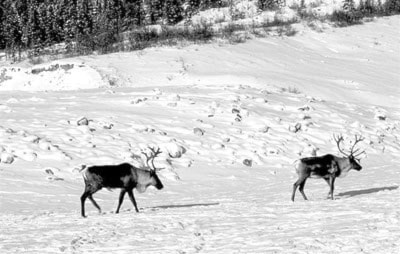Valhalla Wilderness Watch
One of the province’s largest Mountain Caribou herds has declined by approximately 100 animals since the BC government announced its Mountain Caribou Recovery Plan. Government census figures show that the Wells Gray-Thompson River subpopulation declined from an estimated 274 animals in 2007, to an estimated 172 animals in 2011.*
“That’s a steep, alarming rate of decline for the last six years,” says Anne Sherrod, a director of Valhalla Wilderness Watch. The area covered by the census is the Wells Gray-Thompson Planning Unit. It covers about four-fifths of Wells Gray Provincial Park, but also includes caribou residing outside the park. The steepest rate of decline is among caribou outside the park, but caribou in the park are also declining.
The evidence points to massive clearcutting around the park. “The area around the southwestern, southern, and eastern boundaries of the park is an appalling sea of clearcuts and roads,” says Sherrod. “The BC government has allowed clearcutting right up to the park boundaries. It has been well known for years that surrounding parks with clearcuts and roads isolates species at risk and can eventually wipe them out.”
In Wells Gray, wildfires burned through the park’s main valleys in the early 20th century. This created forage supporting great numbers of moose and deer, which in turn supported an increased population of wolves. Biologists say wolves are eating the caribou, but the park’s forest is now approaching the age that will favour caribou and naturally reduce moose, deer and wolves. But clearcutting outside the park keeps creating moose-deer-wolf habitat. “We can’t keep increasing the density of these animals outside the park and expect them not to move into the park,” says Sherrod.
Unfortunately, Canfor is preparing to salvage log in the Clearwater Valley right against the park; other areas in the habitat of the Wells Gray-Thompson herd remain open to logging despite the BC government’s highly celebrated “Mountain Caribou Recovery” Plan. A meagre 6,000 hectares of Timber Harvesting Land Base was partially protected for the Wells Gray-Thompson caribou, and only part of that has been designated for “no logging.” A somewhat larger area of non-commercial forest was also designated, but as a “modified harvest zones” that allow continued logging. Once roaded and cut, these areas will be worthless for caribou.
In 2007 the Liberal government admitted that “Habitat loss and fragmentation has been identified as the underlying cause of mountain caribou population declines since 1995, with mortality by predators as the secondary cause. Halting and reversing habitat loss is central to the plan’s success.” Nevertheless, the government refused to reduce the Allowable Annual Cut in Mountain Caribou habitat, and that severely limited protection of Timber Harvesting Land Base. For an animal that is dependent on intact old-growth forest, that was a disaster.
The government focused instead on killing wolves. Five years later, in its draft Wolf Management Plan, the Liberal government has admitted that its wolf killing programs have not resulted in more caribou. Now the caribou are declining in the North Cariboo Mountains, in the North and South Columbia Mountains, in the South Selkirks and elsewhere. Yet the Liberals continue making the same mistake: instead of expanding habitat protection and eliminating snowmobiling in winter habitat, they now want to kill still more wolves.
Wolf culls may actually work to make the problem worse. Studies show that killing wolves to the point of disrupting their natural pack life can scatter them and increase their reproductive rate. Thus it is possible that the government’s wolf-killing caribou recovery plan has actually increased the number and territory of wolves, sending them into adjacent protected areas. To avoid this, the government now wants to kill 80% of the wolf population around Mountain Caribou areas by machine-gunning whole packs from helicopters.
“Make no mistake, under the cover of these diversions, the BC government is killing caribou slowly, by refusing to protect sufficient habitat, by creating more moose-deer-wolf habitat through logging, and by inadequate snowmobile and heli-skiing closures.” says Sherrod. Residents belonging to the Wells Gray World Heritage Committee (WGWHC) have proposed a moratorium on cutblocks planned by Canfor in the Clearwater Valley (http://www.wellsgrayworldheritage.ca/). Valhalla Wilderness Watch supports this, but is also calling for a cancellation of any further logging anywhere around the park. “The park needs to be expanded to preserve what little intact connectivity and core habitat remain,” says Sherrod.
* Mountain caribou census boundaries are not arranged to count only those caribou in the park. Another subpopulation, the Quesnel Highlands herd, uses the northwest part of the park.
That subpopulation received substantial new protection of Timber Harvesting Land Base in 2009 and is one of the few subpopulations holding steady, with 262 in 2006 and 265 in 2011, but it uses only a small part of Wells Gray Park.
* Article courtesy of Valhalla Wilderness Watch, wildernesswatch@netidea.com
